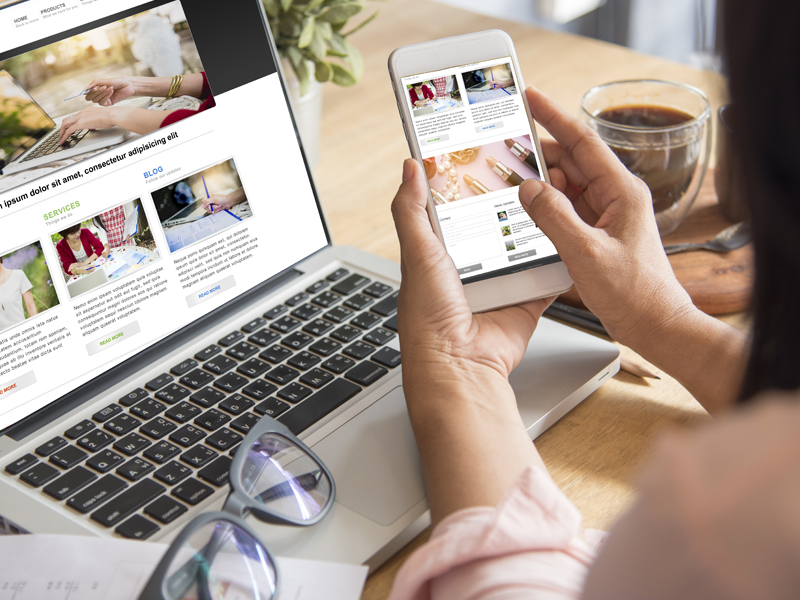
14 Nov Ubiquitous Omnishoppers
These days, most of us, whether we realise it or not, are omnishoppers (shoppers who use technology to make a purchase). According to Mastercard, 80% of global consumers use tech in some way during the buying process. However whilst shoppers use technology to research and make purchases bricks and mortar stores are still important.
Consumers don’t just look for things on one channel, they blend channels and buy items from a variety of places. And this new way of shopping presents a number of marketing challenges as targeting your ideal customer means understanding how they use each channel. At a strategic level, marketers need to understand how their customers use different channels to make buying decisions, both at an individual level and a category level (online and in-store). Then use those findings to personalise their marketing strategies and target people individually.
The three main ways consumers are blending channels before buying are:
- Click and collect: buying an item online and picking it up at a local store.
- Webrooming: doing the research and selection online then going to a bricks and mortar shop to make a purchase.
- Showrooming: the reverse of webrooming – going out to a shop to choose something then buying it online.
A recent report by Criterio showed that 9 out of 10 UK omnishoppers both webroom and showroom. It also shows that behaviours differ from individual to individual – no two consumers are the same or have the same omnishopper profile (Critero Shopper Survey 2017).Omnishoppers are hyper-connected and social, they’re demanding, confident and above all they are highly convenience-focused. With access to all the information they need virtually at their fingertips, they’re happy to research the right product across channels before making a purchasing decision. And, as well as having access to information about your brand, they can find out all they need to about every other retailer too.
So how can you adapt your marketing strategy to reach omnishoppers and engage with them at the right point in the buying cycle?
Here are 4 top tips that we’ve picked up from having supported a wide range of consumer-facing brands navigate the online and offline marketplace recently.
Truly know and understand your consumers
It’s worth investing in understanding your consumers’ motivation for making a purchase. Routes towards purchasing vary for different areas of retail and different age groups, so the data on buyer behaviour that can help you understand your market needs to be specific to your sector and consumer group. Understanding why shoppers use technology in the first place is useful and worth investigating. Recent studies have shown that when shoppers go to a website, they mainly want (in descending order) free returns, discounts, relevant products to appear first, and attractive photos. And they use tech for lots of different reasons. Eighty-percent of shoppers say that technology has enabled them to become smarter shoppers, it allows them to access promotions, for the experience, to get more value, and to discover new brands and designs (Understanding Omnishoppers, Venitism November 2017).
Link all channels
Retailers have to try to bridge the online and retail world by linking all channels. At all three stages of making a purchase (finding out about an item, learning more about it and deciding to buy it), omnishoppers are most influenced by websites and apps. Yet they are also influenced by retail stores, advertising, friends and family recommendations, social media and increasingly by influencer marketing too. Brand engagement and loyalty is key to retaining consumers, so it’s vital to use integrated tech across channels to drive consumers to their preferred online platforms. Appealing visuals and video content create brand associations that can help stand out in the crowded online marketplace. And it’s important to offer consistently excellent quality of service across all channels.
Set up an influencer programme
There are many differences between online and offline shoppers. in terms of purchasing behaviour. Just as an example, online shoppers interact more with influencers than in-store shoppers, and as far as consumer generations go, Millennials place more reliance on influencer marketing than Baby Boomers. If your target market is younger people, an influencer programme will help you reach them. You could use well-known people in the fashion, sport of entertainment world, or social media stars, anyone who’s considered to be a trendsetter or an authority in a certain area – someone people believe, trust and want to emulate. Whoever your target consumer is, in the age of the omnishopper, you should try to tailor your marketing so that your consumers can buy what they want, when they want, wherever and however they choose.
Work with a strategically minded agency
We’ve got more than 15 years’ experience helping brands research, target and engage with their customers to grow their brands. Recently we have worked with our clients to adapt their marketing strategy to become more agile and responsive to the different behaviours displayed by shoppers today. We help you create content which can be used to link all your channels, in order to strengthen your brand presence and customer experience and offer a seamless experience whether your customers are engaging with your brand online, offline or both intermittently.
If you’d like to chat us some more about what this means for your brand, just drop us a line or give us a call.






No Comments